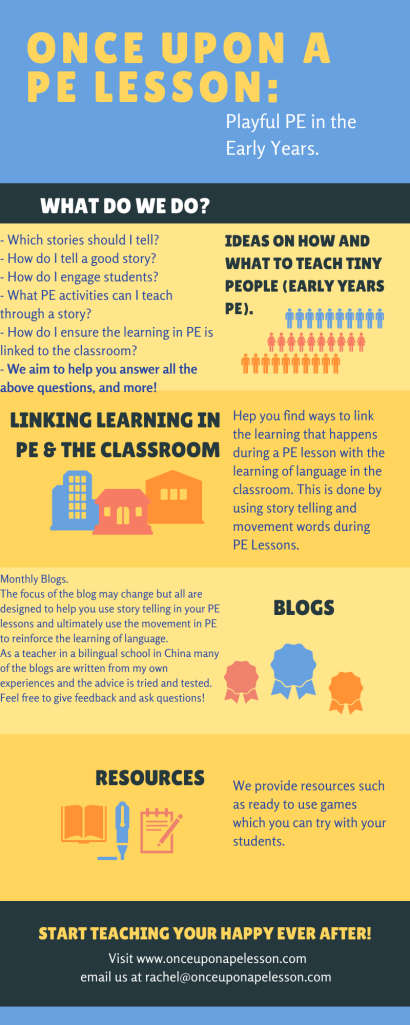Hi there!
My name is Rachel Ford, a qualified PE Teacher from Sheffield, England. I am currently teaching in a Bilingual School in Hangzhou, China.
After graduating I took the leap to teach internationally, first in Malaysia and now in China. Since teaching internationally I have experienced two main difficulties;
- Teaching students who have English as a second or foreign language.
- Teaching Early Years PE.
Through experience, collaboration and CPD I have learned many strategies to help me overcome theses problems. Since teaching in China my passion and enthusiasm towards Early Years PE especially, has grown. I teach across the whole school and love my job but Early Years PE is a favourite area of mine.
As I have developed my Early Years PE programme I have concentrated on keeping PE fun and playful by teaching games through a story.
Students love this!
I love this!
Not only are students fully engaged in the physical challenges you are presenting them with, but their imagination runs wild and inquiry learning takes over. Furthermore, by linking the story being told in the PE lesson to the story and / or theme being taught in the classroom I believe that PE lessons can be used to reinforce the learning of language.
I hope this introduction explains the title ‘Once Upon a PE Lesson: Playful PE in the Early Years’.
Our Aim
To begin with, the thought of teaching early yeas PE can be a scary one. I definitely freaked out and asked myself the following questions:
- What do I teach these tiny people?
- How do I keep their attention?
- Do they really understand?
- Can we just play games?
Our aim is to help you answer these questions by helping you think of ways to make your early years PE lessons playful and purposeful. We have linked moving in PE with the learning of language so that the games we play in PE can be taught through stories and reinforce the language being learned in the classroom. If you are like me and you teach in a country where English is a second or foreign language, this story telling strategy is super helpful!
Since using story telling and movement to reinforce language in my lessons I have managed to keep my students engaged, also I check their understanding through both movement tasks and communication. Additionally I have said goodbye to TWO main worries;
- Students do not understand me at all!
- My lesson is just playtime.
Students may not always understand all of the instructions I am giving them but, because they are familiar with the story being told they can relate and follow along.
Goodbye playtime to pass the time. Hello Purposeful Play!
What does research say?
Numerous pieces of research highlight the importance of play and discovery within early years education. Just as many pieces of research identify the link between being physically active and achieving academically. I have brought together a variety of research which help to justify and plan how the learning of language can be reinforced by movement and physical challenges in PE. Furthermore, how embedding these physical challenges within a story will increase the value of language learning as well as helping to ensure that students are engaged in the lesson.
As I have taught internationally and now in a Bilingual School I also pay special attention as to how learning the English language can be differentiated and made more accessible to those with English as an additional or foreign language. Here are some key points which inspired me to improve my early years PE programme and develop Once Upon a PE Lesson;
• Story telling has been identified as a perfect tool to improve spoken language, written skills and imagination.
• PE teachers can set the scene of their lesson by telling the beginning of a story. This can contribute to a child’s competence in language and writing.
• Stories are perfect for bridging the gap between understanding and experience.
• Students remember stories and characters. This has helped me in my classes as I have set routines, rules and expectations through stories. Students remember!
• Using key movement words help students to increase their vocabulary.
• Within a Bilingual School, stories can be linked across countries and cultures.
• Early years students are typically good at moving and talking, why not combine and progress the two together while capturing students’ imagination.
• Story telling while playing allows the repetition of words. My students definitely know what treasure is, they know how to block, they know how to dodge and they know how to be kind by saying thank you to their friends. My students have also learned about numerous animals and how they move. The repetition of key words through the use of a story during lesson, helped this learning.

